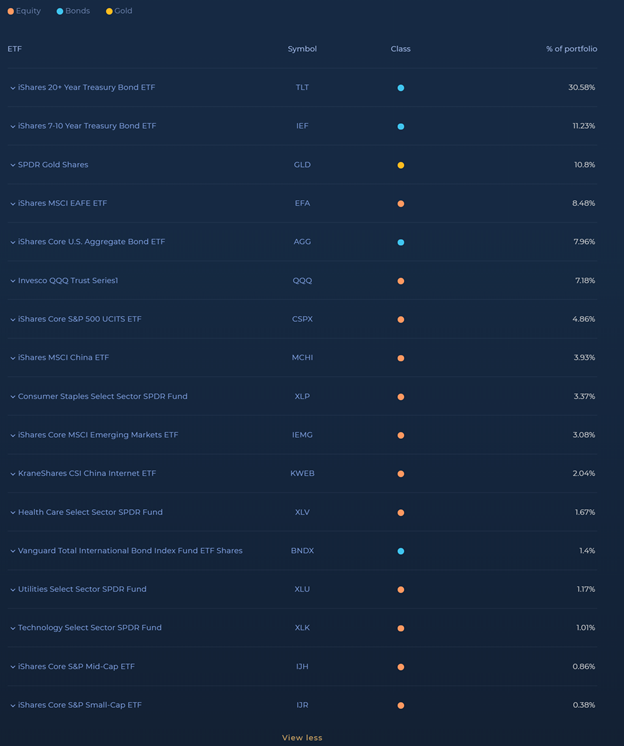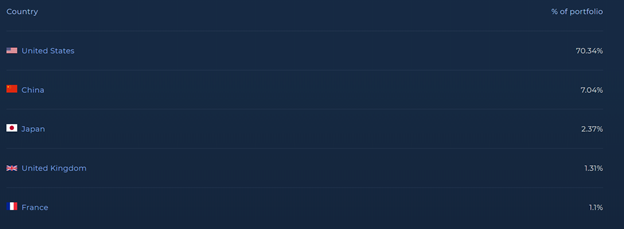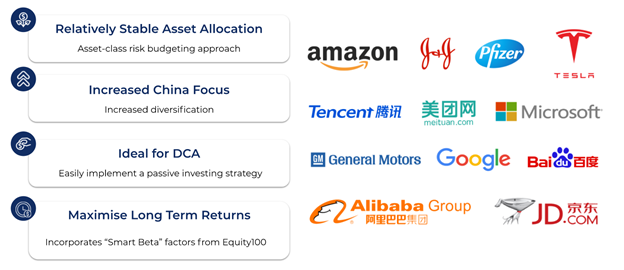
Syfe launched their new Core portfolios recently.
We’ve reviewed their REIT+ and Equity100, so I was quite keen to take a closer look into Syfe Core.
Note: This post is sponsored by Syfe. All views and opinions expressed in this post are from Financial Horse.
What are Syfe Core Portfolios?
Robo-advisors like Syfe or StashAway don’t need any introduction today – they’ve found a good place for themselves in the Singapore investing space.
Basically, you put some money there, and they invest it for you.
Fees are percentage based with no minimum, which makes it a great way for beginner investors to get started in investing. Everything is automated and very welcoming too.
There are 3 Syfe Core portfolios:
• Syfe Core Growth – Higher-risk portfolio that’s designed for growth-oriented investors with a longer time horizon
• Syfe Core Balanced – Medium-risk portfolio designed for moderate investors with a mid-to long-term horizon
• Syfe Core Defensive – Low-risk portfolio designed for conservative investors
As the name suggests, Syfe Core Growth is the highest risk-return, while Syfe Core Defensive is the safest. And Syfe Core Balanced is the balanced one.

Broad asset allocation for all 3 is set out below.
Syfe Core Defensive has approximately 70% allocation to bonds which is really big, while Syfe Core Growth has a 70% allocation to equities, again really big.
So the 3 portfolios are actually very different.

According to the website, Syfe Core Balanced is the most popular, so we’ll review that today.
Asset Allocation
Full ETF breakdown for Syfe Core Balanced is set out below. All 3 Syfe Core portfolios use the same ETFs, just with different allocations.

Syfe Core Balanced is split between equities (38%), bonds (51%), and gold (10%).

Diversification wise – Treasuries come in at 45% of the portfolio. This is expected for a portfolio with 51% allocation to bonds.
After that, it’s the standard mega caps like Apple, Microsoft, Tencent, Alibaba etc.


Geographical Allocation
Geographical allocation is pretty interesting because China comes in at 7%.
We don’t see this often today because many western portfolios skip China.
But I really like this part – I think any investor today needs some exposure to China in their portfolio. China is just going to be a big part of the 21st Century.
The 70% allocation to US includes a 45% allocation to US Treasuries. Looking at equities alone, the exposure to US comes in around 25%.
Another interesting part is the low allocation to Europe, coming in at low single digits.

What makes Syfe Core Portfolio unique?

There are 2 unique points in the Syfe Core Portfolio that we don’t usually see in other robo-advsisors:
• Smart Beta (Factor Tilts)
• China Exposure
Smart Beta (Factor Tilts)
Simply put, our Smart Beta strategy optimises our Core equity selection based on three classical factors: Large-cap, growth, and low-volatility. These factors have been selected to generate better risk-adjusted returns.
In other words – they tilt towards large-cap and growth (via QQQ), and low-volatility (via XLP and XLU).
That’s done very well the past 10 years, but I guess the question is whether that does well going forward.
This is the same Smart Beta strategy used in the Syfe Equity 100 portfolio.
China Exposure
Core is also the first Syfe portfolio to include an enhanced exposure to China and Chinese tech stocks.
…
What we found was that the Chinese market has been outperforming since last year. Beyond providing additional diversification benefits, we believe the China and Chinese tech factors will come into play going forward.
According to Goldman Sachs, China is poised to deliver “one of the strongest and fastest macro recoveries in 2021 among major economies globally”. Investors are increasingly seeking greater exposure to China.
This is a key reason why Core portfolios include the iShares MSCI China ETF (MCHI) and KraneShares CSI China Internet ETF (KWEB). These ETFs are well placed to perform over the long term and provide investors with solid exposure to China’s growth.
I like this.
As discussed above, I think many investors are under allocated to China these days.
China has years of growth ahead of it, and I think as an investor living in Asia, we simply cannot afford to not invest in China.
Historical performance of Syfe Core Portfolios

Historical performance is set out above, which handily outperforms their target benchmarks.
I would caution against placing too much reliance on back testing though.
The past 10 years was a very different investing climate from what the next 10 years will be like.
So historical performance isn’t going to be hugely relevant.
But it does give you a rough benchmark on the kind of returns to watch out for.
Difference with Syfe Global ARI

Syfe also has a Global ARI portfolio, so the big question is how do they differ?
Core portfolios focus on maximising risk-adjusted returns while Global ARI portfolios primarily focus on downside risk protection
In terms of portfolio construction, Global ARI portfolios follow a dynamic asset allocation process to maintain a target portfolio risk level at all times. Core portfolios, on the other hand, achieve relatively stable asset allocations by applying an Asset Class Risk Budgeting approach making it easier to implement a passive investing strategy.
In terms of portfolio offerings, there are only three Core portfolio types to choose from. Global ARI provides 11 portfolio types.

Basically, Global ARI is an active allocation strategy. Based on certain Value at Risk (VAR) metrics, they will adjust allocation in and out of asset classes, to actively manage the downside.
By contrast, Syfe Core is a passive allocation strategy. You go with a fixed allocation to start with, and just stick with it. You rely on the asset allocation to manage your downside (and control your emotions).
When to use Global ARI vs Syfe Core?
Syfe summarises the difference very well in my view:
If you’re an investor who panics whenever you see a large drawdown, Global ARI may provide the peace of mind that helps you stay invested throughout the market volatility.
But if you’re planning to invest for the long haul and don’t mind larger portfolio drawdowns within the short term, then Core may be a more ideal option for you.
…
Another consideration is whether you intend to dollar-cost average (DCA). Core is more suited to a DCA strategy due its stable asset allocation. During market dips, you’ll be able to accumulate more of your investments at lower prices so you end up averaging out your overall investment costs.
On the other hand, Global ARI may be more suited to a lump-sum investing strategy. You may prefer a greater focus on risk management to help control your portfolio drawdown when the market corrects.
I think they just hit the nail on the head here.
Fees

Fees for Syfe Core are exactly the same as Syfe Equity100 and Syfe REIT+.
Any holdings in Syfe REIT+/Syfe Equity100 counts for fees as well.
So if you have $10,000 in Syfe REIT+, and $10,000 in Syfe Core, you enjoy the reduced 0.5%.
What I like about Syfe Core Portfolio
For Beginner Investors
I think roboadvisors like Syfe are a good starting point for beginner investors, or when you’re investing smaller sums.
At smaller sums of $100 – $1000, transaction costs for DIY investing can be really high due to minimum charges.
Just to give an example, if you’re using DBS Vickers Cash Upfront to buy SGX stocks, the minimum is $10.
If you’re investing, $1000, that $10 is a 1% transaction charge.
And when you sell, it’s $25, which is 2.5%.
These things add up over time.
But with Syfe, the fees are percentage based with no minimum. This is great for dollar cost averaging in smaller amounts.
For Experienced Investors
And for more experienced investors – it can be used as part of the portfolio building, especially if you’re looking to build a multi fund / factor tilt kind of strategy.
Example below of how this can be done:

Some investing is better than no investing
It’s like going to the gym right.
Sure, if you know how to bench or deadlift 150kg then you get a big performance boost out of it.
But for beginners, even if you go to the gym and just do some simple weights, it’s still 1000x better if the alternative is staying at home and watching tv.
Same with Syfe.
The platform, the fees, and the ease of use makes it very easy to get started with investing.
And longer term, some investing, is better than not investing at all.
What I dislike about Syfe Core Portfolio
Because Syfe Core Balanced is a long-term passive portfolio, there is a big allocation to treasuries and gold.
Personally, I think those may not be a significant driver of returns in the short term. You can read more about my views on the rising yield environment here.
But I absolutely get why they need to go into a long term portfolio, because long term you do want that kind of diversification to smooth out returns. Especially if you’re building a defensive / balanced portfolio.
And to be fair, there are 3 portfolios available.
For investors who want more risk and less allocation to bonds, there’s always Syfe Core Growth.
Promo Code
For new Syfe clients, don’t forget to use the Syfe Promo Code.
Use code “FINANCIALHORSE” to enjoy Syfe Wealth: Zero management fees for 3 months; Syfe Trade: Additional S$10 bonus on top of existing promotions when users make their first trade
Don’t forget to use it if you’re signing up!
Closing Thoughts: Good place to park cash?
I think there are uses for Syfe Core.
For beginner investors, this can be a great place to start investing at low fees (vs DIY), especially at lower investment amounts.
For advanced investors, this can be used as part of portfolio building, especially if you’re mixing in a bunch of funds to build a specific strategy.
Not everybody wants to spend a lot of time fussing around their portfolio, and automated solutions like this can be a good alternative.
It’s important to understand your risk appetite and investment objectives though. All 3 Syfe Core portfolios are constructed quite differently, so it is important to understand what you’re trying to achieve, and how much risk you’re comfortable with, before picking one.
Love to hear your thoughts!
Note: This post was sponsored by Syfe. All views and opinions expressed in this post are from Financial Horse.
Your description of “Syfe Core Growth – Low-risk portfolio…” and “Syfe Core Defensive – Higher-risk portfolio…” seem to be reversed.
Thanks, have updated this! 🙂
what are your thoughts of syfe core Vs endowus core?
Endowus Core uses actively managed funds, so the approach is very different. It fundamentally comes back to how you see the next decade playing out – is it more of the same (QE fuelled passive investing – favours Syfe), or a return to a more active investing climate (favouring Endowus). I have my own views on this, but it’s definitely not a straightforward call. For newer investors, a simple way to diversify is to buy both.